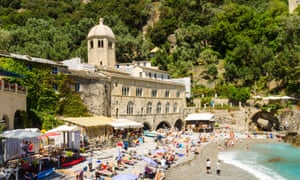 |
Benedictine by the beach … medieval monks decided San Fruttuoso was the spot for their abbey and monastery. Photograph: Alamy
Italy is a nation that loves a bargain, so follow the locals’ example and explore great-value food options, low-cost hotels and cheap – or free – beaches and spas
Italians really know how to stretch their euros on holiday. They may have a reputation for living the dolce vita, but they really, really don’t like spending too much money – parsimonioso in Italian is taken as more of a compliment than an insult. Italians have a nose for a bargain and are great at finding things to do, and beautiful spots to visit, for free. Follow their lead.
Food and drink
Head out to dinner and it quickly becomes apparent that many of the tables in nearby restaurants are occupied by other foreigners, rather than locals. This isn’t just because locals know where the cheaper trattorias are – more likely, they are simply not eating dinner at all. Aperitivo hour is the reason for that: it’s an almost religious ritual of meeting friends for a drink and free, copious snacks, after work. The early evening event not only includes classic drinks, such as Aperol spritz, or a stiff negroni, but all-you-can-eat snacks, like delicious cheese, olives, mini pizzas and regional meats. At Florence’s new Bottega di Pasticceria, for example, the first drink comes with thinly cut prosciutto and bruschetta, among other cocktail snacks, all for just €10 (subsequent drinks cost €5). Or at Rome’s Salotto 42, artisanal cocktails – from €10 – such as moscow mules (strangely, the Italian cocktail of the moment), are served with little gourmet sandwiches.
When in Italy, do as the Italians do: only have one big meal a day, but take full advantage of the all-you-can-eat breakfast (usually included in hotel prices) to fuel up. If you need lunch, it can consist of panini or small plates, saving money for dinner. Cichetti are the Venetian equivalent of tapas: for lunch, locals nibble croquettes filled with baccalà (dried salt cod) and sip glasses of soave at spots such as the wonderful Vini al Bottegon (Fondamenta Nani 992), which has an excellent and well-priced wine list, too.
In Florence, panini have made a comeback at spots like ’Ino near the Uffizi gallery and Ponte Vecchio, where the word “sandwich” doesn’t do justice to the delicious, fresh bread filled with local meats, cheese and other seasonal ingredients.
Italian picnics are usually bacchanalian affairs: prosecco, salami, mozzarella, fresh bread and biscotti, melons, figs and tomatoes, say, all easily picked up at alimentari (food shops and bakeries) in every town.
Accommodation
For most Anglo-Saxons, the idea of haggling over a hotel room price would seem downright rude. Not so for holidaying Italians, who make a sport of it. Try asking for a discount, or some extras to be included, as a way to make those holiday euros go further.
Another Italian trick is to ask hotels or guesthouses whether they have a better-priced apartment option. Gianni Franzi (doubles from €90 B&B) in the Cinque Terre honeypot village of Vernazza, for example, has, in addition to the main hotel, room rentals in other buildings, some with beautiful terraces and idyllic sea views.
As appealing as a chic hotel or villa might be, Italians tend to favour more homely spots, such as an agriturismo – one of the thousands of working farms across the country with rooms or apartments at a fraction of hotel prices. This type of stay gives a real insight into the lives of the local people who farm the land. At Agriturismo Bagnolo (doubles from €80 B&B), outside Pienza in Tuscany’s Val d’Orcia, the spectacular views of the Unesco-protected countryside, home-produced pecorino cheese and sense of seclusion come for about a quarter of the price of a boutique bolthole.
And while the term “glamping” may not be common parlance yet, the Italians are already doing it in serious style. Among boho-chic spots is Il Baciarino (doubles from €70) by the Tuscan coast, where four stone cottages (soon to be five) sit in the hills with jaw-dropping sea views, and jacuzzis heated by wood fires.
Beaches and spa towns
Images abound of endless rows of beach chairs and umbrellas but renting one of these set-ups can cost upwards of €20 a day, even €100-plus in high season in very popular spots. Many Italians prefer to head to one of the rugged, free – or discounted – and often beautiful beaches. The Maremma national park, for example, is a huge swath of protected land with hiking trails, wildlife and wide beaches with pristine sea. Park entry costs from €6 an adult, €4 a child.
Free beaches such as San Fruttuoso are preferred by Italians for the great family-run restaurants that line them (serving meals such as trofie pasta with pesto, then a fish fritto misto). San Fruttuoso also has a beautiful 10th-century abbey on the seashore.
In Sardinia, locals and Italian visitors avoid overpriced beaches near Porto Cervofor the white sands and turquoise sea of national parks like La Maddalena archipelago, a spectacular protected area of seven main islands and 55 tiny islets.
Italians also know how to take the waters of the country’s many natural thermal baths without shelling out for an overpriced spa. Head to small towns such as Bagni San Filippo, Bagno Vignoni and Rapolano Terme and, instead of paying an entrance fee at one of the crowded spa hotels, head to the free baths a short walk away. Ask for directions and enjoy the warm, restorative pools with a good, well-priced bottle of vino.
By Ondine Cohane
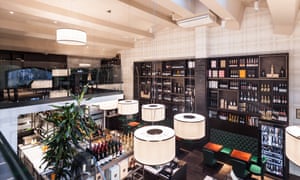

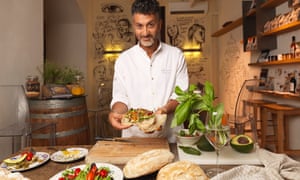
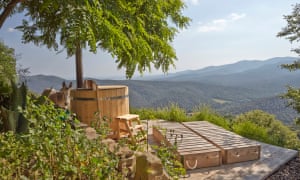
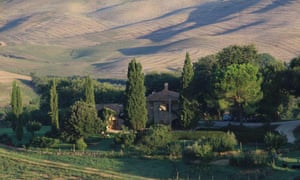
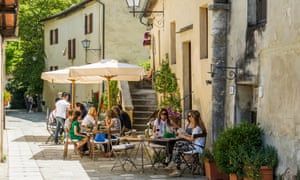

No comments:
Post a Comment